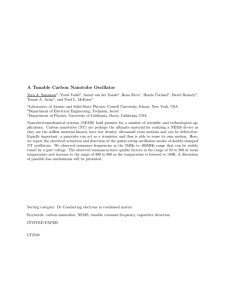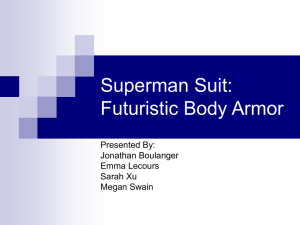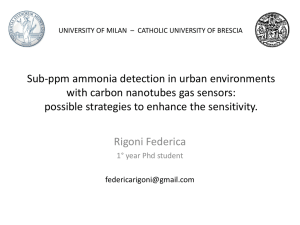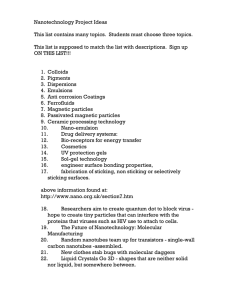Optical Switching of Single-Wall Carbon Nanotube Absorption Through Field Gating
advertisement
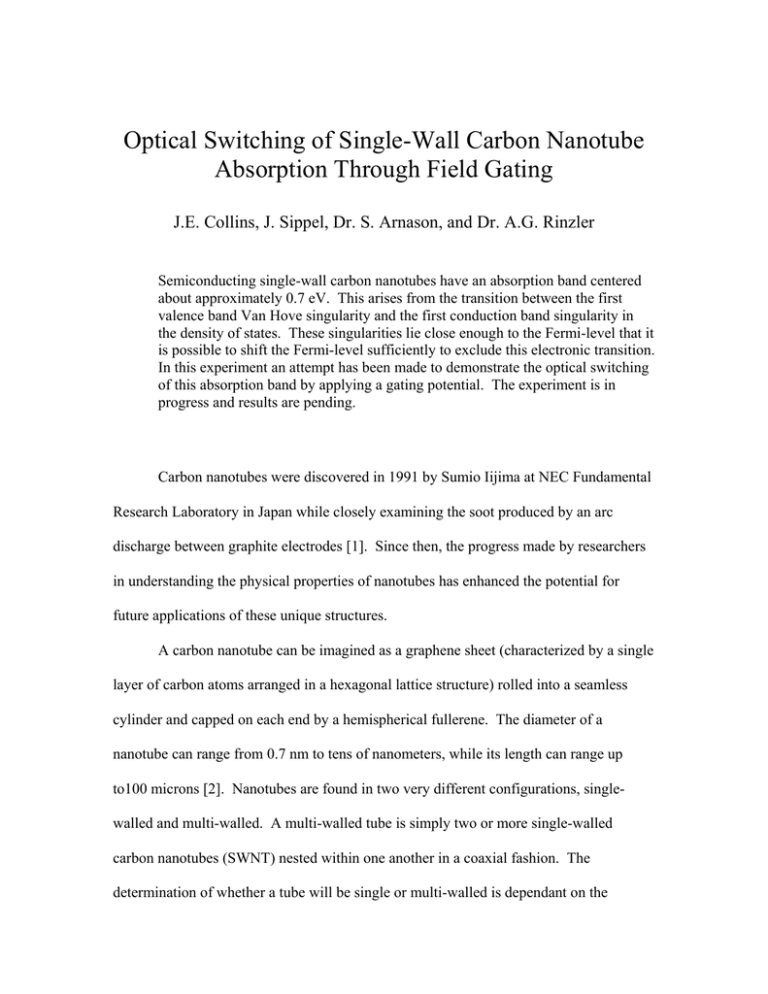
Optical Switching of Single-Wall Carbon Nanotube Absorption Through Field Gating J.E. Collins, J. Sippel, Dr. S. Arnason, and Dr. A.G. Rinzler Semiconducting single-wall carbon nanotubes have an absorption band centered about approximately 0.7 eV. This arises from the transition between the first valence band Van Hove singularity and the first conduction band singularity in the density of states. These singularities lie close enough to the Fermi-level that it is possible to shift the Fermi-level sufficiently to exclude this electronic transition. In this experiment an attempt has been made to demonstrate the optical switching of this absorption band by applying a gating potential. The experiment is in progress and results are pending. Carbon nanotubes were discovered in 1991 by Sumio Iijima at NEC Fundamental Research Laboratory in Japan while closely examining the soot produced by an arc discharge between graphite electrodes [1]. Since then, the progress made by researchers in understanding the physical properties of nanotubes has enhanced the potential for future applications of these unique structures. A carbon nanotube can be imagined as a graphene sheet (characterized by a single layer of carbon atoms arranged in a hexagonal lattice structure) rolled into a seamless cylinder and capped on each end by a hemispherical fullerene. The diameter of a nanotube can range from 0.7 nm to tens of nanometers, while its length can range up to100 microns [2]. Nanotubes are found in two very different configurations, singlewalled and multi-walled. A multi-walled tube is simply two or more single-walled carbon nanotubes (SWNT) nested within one another in a coaxial fashion. The determination of whether a tube will be single or multi-walled is dependant on the method used to produce the tube. The tubes Iijima observed in 1991 were multi-walled tubes. In 1993 Donald Bethune and colleagues at an IBM research center found that by adding a transition-metal catalyst in conjunction with the electric arc method of producing nanotubes, SWNT would be formed [3]. The SWNT, because of their simpler and more well defined structure, are preferred in studying the basic principles of nanotubes. In 1995, Richard Smalley and his associates at Rice University used a laser vaporization technique that produces SWNT in yields of up to 70-80%. Previous techniques produced yields of only 4-6% [3]. This improved method of production was a breakthrough in that it provided the bulk material needed by researchers to study nanotubes on a larger scale. Nanotubes exhibit many fascinating physical properties. They are extremely resilient and lightweight. They also possess a high tensile strength and thermal stability[3]. These mechanical properties give rise to an extremely broad range of potential applications. Perhaps the nanotubes’ most interesting properties belong to the area of electronics. Because of the semi-metal nature of a graphene sheet and the small diameter of this cylindrical surface when in the form of a nanotube,a nanotube can be classified as either a metal or a semi-conductor, based solely on the size of its diameter and its chirality. The chirality is the “twist” of the nanotubes hexagonal lattice-structured wall [3]. Calculations of the rigid band model as well as experimental data have shown that about one-third of all SWNT are metallic while the remaining are semi-conducting [4]. The fundamental energy gap is 0 in the metallic and on the order of about .5eV in semi-conducting tubes [5]. The fundamental gap in the semi-conductors varies according to a function of both the tube’s diameter and its chirality. This array of different types of nanotubes supplies a plausible material for the production of novel nanoscale electronic devices. In fact, field effect transistors (FETs) have already been made using a semiconducting nanotube and have been reported to work as well as FETs made by conventional methods [4]. What makes this remarkable is that the nanotube is a single molecule, far smaller than conventional FETs, which suggests the possibility of packing far more power into future computer chips. The goal of the experiment I am working on is to exploit one of the unique properties displayed by nanotubes in order to demonstrate the practicability of using them as an efficient optical switch operating in the near infra-red region of the optical spectrum. Experiments previously performed have shown that the Fermi level of singlewalled nanotubes could be finely tuned through doping. In one of these experiments, a thin film of SWNT was chemically doped using controlled amounts of alkali metals (electron donors) or halogens (electron acceptors, “hole” doping) as the dopants [6]. In a later experiment by the same group, the SWNT were electrochemically doped [7]. The effect of the doping was monitored by absorption spectroscopy which showed the disappearance of absorption bands as the Fermi level was shifted enough to either deplete the valence band or fill the conduction band for the corresponding optical transition [6,7]. In our experiment, we set out to effect the doping in the solid state by field gating, avoiding chemical doping or the use of an electrolytic solution. Our device would enable us to turn on or off the absorption of a thin film of SWNT by simply adjusting a power source. Absorption bands in the nanotubes occur due to transitions between pairs of VanHove singularities. These singularities are spikes in the density of states (see Fig. 1) which occur at specific energies, depending on nanotube diameter and chirality. Fig. 1. Calculated DOS of metallic(top (10,10)) and semiconducting SWNT(bottom (12,8)). The transitions between the lowest van Hove singularity (v1 c1) and the next lowest singularity (v2 c2) are no more in this case of doping, since the Fermi energy Ef is shifted (as indicated by the patterned areas for p-type doping)[6]. For samples containing many nanotubes the absorptions corresponding to these transitions occur in broad bands (because of the variation in diameter and chirality) at 1800 (.7eV), 1000 (1.2eV), and 700nm (1.8eV) [6]. The absorption bands at .7 and 1.2eV correspond to the semi-conducting tubes in the sample, while the 1.8eV transition belongs to metallic nanotubes [8]. The measurements we made in this experiment were taken with a Perkin-Elmer UV/Vis spectrometer operating in % transmission mode. A background correction was performed to single out the spectrum of the tubes from other materials on our substrates. A typical spectrum of a thin film of SWNT can be seen in Fig. 2.We anticipate to change this observed spectrum through adjustment of an applied gating voltage by adding or depleting the film of electrons available for specific energy transitions. Or more precisely, we hope to shift the fermi level of the nanotubes. FIGURE 2. Spectrum of SWNT film. 9967.9 9960 9950 9940 9930 %T 9920 9910 9900 9889.1 500.0 800 1000 1200 1400 NANOMETERS 1600 1800 2000.0 This experiment was originally designed in the following manner. A metallic layer of indium oxide is first deposited on a quartz substrate followed by an insulating layer of aluminum oxide. The aluminum oxide covers all of the indium oxide except for a protruding piece which is needed for electrical contact. These films are on the order of hundreds of angstroms thick and were deposited using an ion-beam sputtering technique. A layer of nanotubes is then deposited atop the aluminum oxide by an evaporative deposition method utilizing a solution of nanotubes suspended in Dimethylformamide (DMF). The tubes used were produced by the laser vaporization method and underwent a series of purification steps. Semi-conducting and metallic tubes are present, in a ratio of 2:1, respectively. This substrate is subsequently baked to a temperature of 450 C to remove any DMF residue as well as possible impurities. After removing the substrates from the furnace, we apply a second indium oxide layer. The succession of layers deposited on the quartz is shown in Fig. 3. Three samples were prepared, one with nanotubes and two without. The two samples without nanotubes are used to provide for the background correction needed in the spectrometer. This setup provides a convenient way to apply a gating voltage to the tubes in order to add or deplete them of electrons. The sample with tubes was placed in the sample beam of the spectrometer and spectrums were taken first at 0 applied voltage, then in alternating positive and negative voltages in increments of .1 V. The expected result was to first see the known peak at .7eV disappear as we depleted the nanotubes of possible electrons or holes available to make this transition. Unfortunately, even after approaching a voltage of 2 V, we were unable to see any definitive or identifiable results. This outcome forced us to look at the possible flaws in the experiment and prompted us to make a fundamental change. Because of defects in the insulating layer, it is usually hard to make large area gates. It is likely that with the large area we used to accommodate the optical aperture of our spectrometer that our thin Al2O3 insulating layer broke down at a relatively low voltage. The current, which was being monitored, indicated this to be the case. This could explain our lack of any observed effect. To solve this problem, we eliminated the second layer of indium oxide, relying on the conductivity of the nanotubes themselves to transport the doping over the entire nanotube layer from gold electrodes deposited as shown in Figure 4. These electrodes do not overlap the first indium oxide electrode at all. We will deposit a sufficient density of tubes on the surface for charge carriers to move freely between tubes on the surface to and from the gold electrode. The experiment is still in progress with results pending FIGURE 3: Illustration of succession of layers deposited on Quartz substrate(original method) TOP VIEWS: 1st layer: 2nd layer: aluminum oxide 4th layer: Nanotubes indium oxide SWNT SWNT indium oxide 3rd layer: SIDE VIEW: 2nd indium oxide SWNT thin film Aluminum oxide Indium oxide quartz substrate FIGURE 4: Improved method utilizing gold electrodes in place of second indium oxide layer. 2nd layer: Aluminum oxide 3rd layer: Nanotubes SWNT SWNT 1st layer: Indium oxide 4th layer: Gold References [1] B. Yakobson and R. Smalley, Am. Scientist 85, 324-337 (1997). [2] R. Saito, G. Dresselhaus, and M.S. Dresselhaus, Physical Properties of Carbon Nanotube (Imperial College Press, London, 1998). [3] C. Dekker, Phys. Today 52, 22 (1999). [4] P. Collins and P. Avouris, Sci. American (Dec 2000). [5] Jeroen W. G. Wilder, Liesbeth C. Venema, Andrew G. Rinzler, Richard E. Smalley, and Cees Dekker, Nature 391, 6662, 59-62 (1998). [6] S. Kazoui, D. Yu, R. Jacquemin, A. Hassanien, H. Kataura, and Y. Achiba, Synth. Met. 115, 283-287 (2000). [7] S. Kazoui, N. Minami, N. Matsuda, H. Kataura, and Y. Achiba, Appl. Phys. Let. 78, 22 (2001). [8] H. Kataura, Y. Kumasawa, Y. Maniwa, I. Umeza, S. Suzuki, Y.Ohtsuka, and Y. Achiba, Synth. Met. 103, 2555 (1999). ACKNOWLEDGEMENTS I would like to sincerely thank Dr. Andrew Rinzler and his graduate students, Jennifer Sippel, Hidenori Tashiro, Amol Patil, and Zhihong Chen for all of their time and effort in assisting me this summer. Also Dr. Art Hebard and Dr. Steve Arnason and their lab associates for their thin film depositions and knowledgeable input. Thank you to Drs. Dorsey and Ingersent for their coordination of the REU program and for granting me the opportunity to participate and the NSF for providing the funding for this summer research program.



